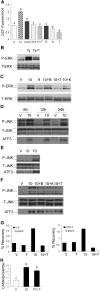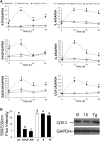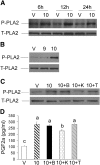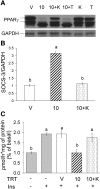Inflammation and insulin resistance induced by trans-10, cis-12 conjugated linoleic acid depend on intracellular calcium levels in primary cultures of human adipocytes
- PMID: 20154361
- PMCID: PMC2882722
- DOI: 10.1194/jlr.M005447
Inflammation and insulin resistance induced by trans-10, cis-12 conjugated linoleic acid depend on intracellular calcium levels in primary cultures of human adipocytes
Abstract
We previously demonstrated that trans-10, cis-12 (10,12) conjugated linoleic acid (CLA) induced inflammation and insulin resistance in primary human adipocytes by activating nuclear factor kappaB (NFkappaB) and extracellular signal-related kinase (ERK) signaling. In this study, we demonstrated that the initial increase in intracellular calcium ([Ca2+]i) mediated by 10,12 CLA was attenuated by TMB-8, an inhibitor of calcium release from the endoplasmic reticulum (ER), by BAPTA, an intracellular calcium chelator, and by D609, a phospholipase C (PLC) inhibitor. Moreover, BAPTA, TMB-8, and D609 attenuated 10,12 CLA-mediated production of reactive oxygen species (ROS), activation of ERK1/2 and cJun-NH2-terminal kinase (JNK), and induction of inflammatory genes. 10,12 CLA-mediated binding of NFkappaB to the promoters of interleukin (IL)-8 and cyclooxygenase (COX)-2 and induction of calcium-calmodulin kinase II (CaMKII) beta were attenuated by TMB-8. KN-62, a CaMKII inhibitor, also suppressed 10,12 CLA-mediated ROS production and ERK1/2 and JNK activation. Additionally, KN-62 attenuated 10,12 CLA induction of inflammatory and integrated stress response genes, increase in prostaglandin F2alpha, and suppression of peroxisome proliferator activated receptor gamma protein levels and insulin-stimulated glucose uptake. These data suggest that 10,12 CLA increases inflammation and insulin resistance in human adipocytes, in part by increasing [Ca2+]i levels, particularly calcium from the ER.
Figures








Similar articles
-
Conjugated linoleic acid promotes human adipocyte insulin resistance through NFkappaB-dependent cytokine production.J Biol Chem. 2005 Nov 18;280(46):38445-56. doi: 10.1074/jbc.M508159200. Epub 2005 Sep 9. J Biol Chem. 2005. PMID: 16155293 Free PMC article.
-
Conjugated linoleic acid-mediated inflammation and insulin resistance in human adipocytes are attenuated by resveratrol.J Lipid Res. 2009 Feb;50(2):225-32. doi: 10.1194/jlr.M800258-JLR200. Epub 2008 Sep 5. J Lipid Res. 2009. PMID: 18776171 Free PMC article.
-
Diacylglycerol kinase inhibitor R59022 attenuates conjugated linoleic acid-mediated inflammation in human adipocytes.J Lipid Res. 2013 Mar;54(3):662-670. doi: 10.1194/jlr.M031211. Epub 2012 Dec 22. J Lipid Res. 2013. PMID: 23264678 Free PMC article.
-
The effect of reactive oxygen species on the synthesis of prostanoids from arachidonic acid.J Physiol Pharmacol. 2013 Aug;64(4):409-21. J Physiol Pharmacol. 2013. PMID: 24101387 Review.
-
Human Protein Kinases and Obesity.Adv Exp Med Biol. 2017;960:111-134. doi: 10.1007/978-3-319-48382-5_5. Adv Exp Med Biol. 2017. PMID: 28585197 Review.
Cited by
-
Conjugated linoleic acid-induced apoptosis in mouse mammary tumor cells is mediated by both G protein coupled receptor-dependent activation of the AMP-activated protein kinase pathway and by oxidative stress.Cell Signal. 2011 Dec;23(12):2013-20. doi: 10.1016/j.cellsig.2011.07.015. Epub 2011 Jul 23. Cell Signal. 2011. PMID: 21821121 Free PMC article.
-
miRNAs and Novel Food Compounds Related to the Browning Process.Int J Mol Sci. 2019 Nov 28;20(23):5998. doi: 10.3390/ijms20235998. Int J Mol Sci. 2019. PMID: 31795191 Free PMC article. Review.
-
Prostaglandin F2α requires activation of calcium-dependent signalling to trigger inflammation in human myometrium.Front Endocrinol (Lausanne). 2023 Jul 19;14:1150125. doi: 10.3389/fendo.2023.1150125. eCollection 2023. Front Endocrinol (Lausanne). 2023. PMID: 37547305 Free PMC article.
-
A review on effects of conjugated linoleic fatty acid (CLA) upon body composition and energetic metabolism.J Int Soc Sports Nutr. 2015 Sep 17;12:36. doi: 10.1186/s12970-015-0097-4. eCollection 2015. J Int Soc Sports Nutr. 2015. PMID: 26388708 Free PMC article. Review.
-
Metabolically distinct weight loss by 10,12 CLA and caloric restriction highlight the importance of subcutaneous white adipose tissue for glucose homeostasis in mice.PLoS One. 2017 Feb 28;12(2):e0172912. doi: 10.1371/journal.pone.0172912. eCollection 2017. PLoS One. 2017. PMID: 28245284 Free PMC article.
References
-
- Centers for Disease Control and Prevention. US Obesity Trends, 1985–2006. Accessed 2007 at http://www.cdc.gov/nccdphp/dnpa/obesity/trend/maps/index.htm.
-
- Whigham L. D., Watras A. C., Schoeller D. A. 2007. Efficacy of conjugated linoleic acid for reducing fat mass: a meta-analysis in humans. Am. J. Clin. Nutr. 85: 1203–1211. - PubMed
-
- Granlund L., Juvet L. K., Pedersen J. I., Nebb H. I. 2003. Trans10, cis12-conjugated linoleic acid prevents triacylglycerol accumulation in adipocytes by acting as a PPARgamma modulator. J. Lipid Res. 44: 1441–1452. - PubMed
Publication types
MeSH terms
Substances
Grants and funding
LinkOut - more resources
Full Text Sources
Research Materials
Miscellaneous

